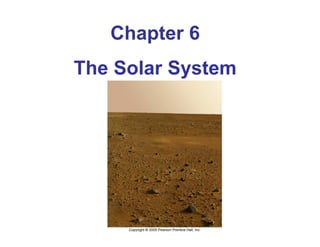Lecture Ch 06 [Compatibility Mode] Ast 201
- 1. Chapter 6 The Solar System y
- 2. Units of Chapter 6 An Inventory of the Solar System Planetary Properties Computing Planetary Properties The Overall Layout of the Solar System Terrestrial and Jovian Planets Interplanetary Debris
- 3. Units of Chapter 6, cont. Spacecraft Exploration of the Solar System Gravitational “Slingshots” g How Did the Solar System Form? The C Th Concept of Angular Momentum t fA l M t
- 4. 6.1 An Inventory of the Solar System Early Earl astronomers kne Moon, stars, Merc r knew Moon stars Mercury, Venus, Mars, Jupiter, Saturn, comets, and meteors Now known: Solar system has 135 moons, one star, star nine planets (added Uranus Neptune and Uranus, Neptune, Pluto), asteroids, comets, and meteoroids
- 6. 6.2 Planetary Properties • Distance from Sun known by Kepler’s laws • Orbital period can be observed • Radius known from angular size • Masses from Newton’s laws • Rotation period from observations • Density can be calculated knowing radius and mass
- 7. 6.4 Terrestrial and Jovian Planets Terrestrial planets: Mercury, Venus, Earth, Mars Jovian planets: Jupiter, Saturn, Uranus, Neptune Pluto is neither
- 8. 6.4 Terrestrial and Jovian Planets Differences between the terrestrial planets: • Atmospheres and surface conditions are very dissimilar di i il • Only Earth has oxygen in atmosphere and liquid water on surface • Earth and Mars rotate at about the same rate; Venus and Mercury are much slower and Venus rotates in the slower, opposite direction • Earth and Mars have moons; Mercury and Venus don’t • Earth and Mercury have magnetic fields; Venus and y g ; Mars don’t
- 9. 6.6 Spacecraft Exploration of the y Solar System Sojourner was deployed on Mars in 1997:
- 10. 6.7 How Did the Solar System Form? Nebular N b l contraction: i Cloud of gas and dust contracts due to gravity; conservation of angular momentum means it spins faster and faster as it contracts
- 11. 6.7 How Did the Solar System Form? Condensation theory: y Interstellar dust grains help cool cloud, and act as condensation nuclei
- 12. Summary of Chapter 6 • Solar system consists of Sun and everything orbiting it • Asteroids are rocky, and most orbit between orbits of Mars and Jupiter p • Comets are icy, and are believed to have formed early in the solar system s life system’s • Major planets orbit Sun in same sense, and all but Venus rotate in that sense as well • Planetary orbits lie almost in the same plane
- 13. Summary of Chapter 6, cont. • Four inner planets – terrestrial planets – are rocky, small, and dense y • Four outer planets – jovian planets – (omitting Pluto) are gaseous and large • Nebular theory of solar system formation: cloud of gas and dust gradually collapsed under its own gravity, spinning faster as it shrank •C d Condensation theory says dust grains acted as ti th d t i t d condensation nuclei, beginning formation of larger objects












